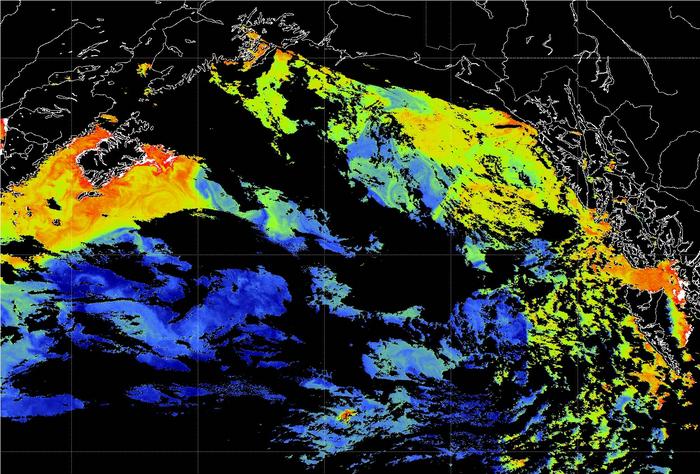As society grapples with the intensifying consequences of climate change, decision makers are increasingly looking to carbon dioxide removal as a necessary complement to emission reductions. One of the strategies that has received the most attention is the idea of fertilizing parts of the ocean with iron to stimulate phytoplankton growth. A team of researchers from Bigelow Laboratory have developed a mathematical model that estimates the potential costs of undertaking large-scale iron fertilization by either plane or ship. They focus on the oceanographic parameters that are likely to determine the effectiveness of the strategy, finding a nearly 100-fold difference in cost between the best- and worst-case scenarios.

Credit: NASA Earth Observatory
As society grapples with the intensifying consequences of climate change, decision makers are increasingly looking to carbon dioxide removal as a necessary complement to emission reductions. One of the strategies that has received the most attention is the idea of fertilizing parts of the ocean with iron to stimulate phytoplankton growth. A team of researchers from Bigelow Laboratory have developed a mathematical model that estimates the potential costs of undertaking large-scale iron fertilization by either plane or ship. They focus on the oceanographic parameters that are likely to determine the effectiveness of the strategy, finding a nearly 100-fold difference in cost between the best- and worst-case scenarios.
In addition, the researchers found that iron delivery by plane, which hasn’t been widely considered, could be more cost effective than ship delivery, but also that verifying that carbon is being fixed in the deep ocean long-term and monitoring environmental impacts could add significant costs. Their findings, published recently in the journal Earth’s Future, will help researchers identify the largest uncertainties of doing ocean iron fertilization — and their cost.
“The primary reason for creating this cost model wasn’t to figure out the economics of iron fertilization exactly,” said Senior Research Scientist and lead author David Emerson. “It was to show how cost varied based on the uncertainty of all the different oceanographic aspects, including the less obvious ones, that need to be accounted for.”
Iron fertilization, like several other marine carbon dioxide removal strategies, is meant to enhance a natural process. Minimal iron availability is the primary limiting factor for phytoplankton growth in nearly one third of the ocean, including the vast Southern Ocean. When even a relatively small amount of the nutrient is added to those ecosystems — whether through natural or artificial processes — it stimulates blooms of phytoplankton. These organisms absorb carbon dioxide dissolved in the ocean from the air and, when they die, may sink it down to the ocean floor for the foreseeable future.
The cost of enhancing this process at large scales depends largely on its efficacy in terms of how much carbon makes it to the deep ocean and stays there.
“We can confidently go out and create a phytoplankton bloom with iron, but the question is how much of the carbon actually ends up getting exported into the ocean, not just over days and weeks but over years and decades,” said Senior Research Scientist Ben Twining, a co-author on the study.
The team built their economic model assuming a range of possible efficiencies at each step of the process, with different estimates of how much carbon can be taken up by phytoplankton, how much is converted back into carbon dioxide and re-released, and how much sinks to the deep ocean. They also explored the possibility that microbes that would feed on all this new plant matter could produce nitrous oxide, a far more potent greenhouse gas. On top of that, the model considers some of the logistical costs, from producing and processing the iron to operating a plane or ship to seed and monitor the resulting bloom.
The uncertainties in how the ocean would respond to iron fertilization, and how biologically efficient the process would be, resulted in a huge price range, from as little as $7 per ton of carbon removed to $1,500 per ton. When the costs of verification are included, that can increase the dollar per ton cost another three to four-fold.
The researchers caution that the exact numbers the model produces are at this point still just best estimates, but they are helpful for putting tangible values on the uncertainties in the process. To that end, the model emphasizes the need for more research particularly into how “permanent” this is as a potential solution and the risks of producing additional greenhouse gases. It also highlights the need for more information on verification methods and aerial delivery.
“The real value of this work is not the exact numbers we came up with but how it highlights where the greatest uncertainties are,” Twining said. “Models are useful, not because they give you an exact answer, but because they give you a framework for figuring out what you need to work on next.”
Journal
Earth s Future
Method of Research
Computational simulation/modeling
Subject of Research
Cells
Article Title
A cost model for ocean iron fertilization as a means of carbon dioxide removal that compares ship- and aerial-based delivery, and estimates verification costs
Article Publication Date
29-Mar-2024



